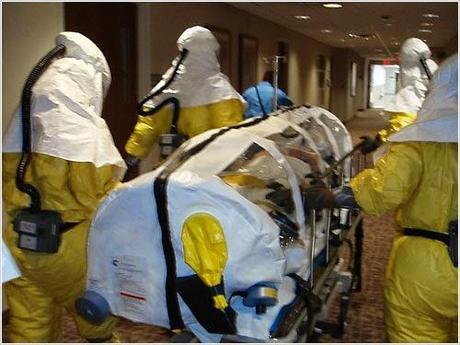
Training exercise, Nebraska Biocontainment Unit brochure
The Nebraska Medical Center, Omaha Nebraska, put out a press release in July 2014. It stated,Ebola Outbreak: Qualified and Prepared
In late July 2014, representative from the U.S. State Department recently visited The Nebraska Medical Center to take a closer look at the capabilities of our 10 bed Biocontainment Unit. There are no current plans for Ebola patients to be transferred here. This was strictly a fact-finding mission, to make government officials aware of the unit’s capabilities in case the need arises for treatment of additional patients with the Ebola virus here in the U.S. The unit has been operational for nearly ten years and is one of four such units in the country equipped to handle an outbreak of this nature.A few thoughts:
--Ten beds? In an outbreak where a 'biocontainment unit' is needed, 10 isn't that many beds.
--One of four Units in the US? Where are the other three? Maybe they have more beds. The National Institute of Health (NIH) Clinical Center, Bethesda Maryland, has 3 beds. Emory Hospital, Atlanta has 3 beds and St Patrick's Hospital, Missoula Montana has 3 beds. Nineteen beds total in the US. Oops, Nebraska's ten seems like an embarrassment of riches compared to paltry 3 in the other places.
--I guess those 'no current plans' to receive patients in July turned into 'you must open for business now' in October
It is hopeful to read that "And any hospital equipped to care for a tuberculosis patient can care for an Ebola patient, according to Dr. George Risi, an infectious disease specialist who recently returned from spending 20 days in a Sierra Leone Ebola ward." But it still doesn't make it a Biohazard level-4 facility.
Ebola virus causes a medical response to a Biohazard Safety level-4 (BSL-4). It is the highest level.
Biosafety level 1
This level is suitable for work involving well-characterized agents not known to consistently cause disease in healthy adult humans, and of minimal potential hazard to laboratory personnel and the environment (CDC,1997)
Biosafety level 2
This level is similar to Biosafety Level 1 and is suitable for work involving agents of moderate potential hazard to personnel and the environment. It includes various bacteria and viruses that cause only mild disease to humans, or are difficult to contract via aerosol in a lab setting, such as C. difficile, most Chlamydiae, hepatitis A, B, and C, orthopoxviruses (other than smallpox), influenza A, Lyme disease, Salmonella, mumps, measles, scrapie, MRSA, and VRSA.
Biosafety level 3
This level is applicable to clinical, diagnostic, teaching, research, or production facilities in which work is done with indigenous or exotic agents which may cause serious or potentially lethal disease after inhalation. It includes various bacteria, parasites and viruses that can cause severe to fatal disease in humans but for which treatments exist, such as Yersinia pestis (causative agent of plague), Francisella tularensis, Leishmania donovani, Mycobacterium tuberculosis, Chlamydia psittaci, Venezuelan equine encephalitis virus, Eastern equine encephalitis virus, SARS coronavirus, Coxiella burnetii, Rift Valley fever virus, Rickettsia rickettsii, several species of Brucella, rabies virus, chikungunya, yellow fever virus, and West Nile virus.
Biosafety level 4
This level is required for work with dangerous and exotic agents that pose a high individual risk of aerosol-transmitted laboratory infections, agents which cause severe to fatal disease in humans for which vaccines or other treatments are not available, such as Bolivian and Argentine hemorrhagic fevers, Marburg virus, Ebola virus, Lassa virus, Crimean-Congo hemorrhagic fever, and various other hemorrhagic diseases. This level is also used for work with agents such as smallpox that are considered dangerous enough to require the additional safety measures, regardless of vaccination availability.
Source for above, Wikipedia
Praise God there are medical personnel willing to work with BSL-4 patients!
I was glad to read that the patient being monitored at Queens Hospital in Honolulu does NOT have Ebola, according to reports.
Interesting article below. The author does a lot of math... and a little scaremongering. Though the numbers she uses are like-to-like, the scenario between W. Africa and the US has a few additional variables than simply numbers. In West Africa, rural clinics are so poor they habitually reuse needles. As a result, standards are different. Also, governments vary in their responses and protocols.
Though a disease will do what it will do whether it emerges in West Africa or the US, there is more to compare than just numbers to numbers. However, in one article I read, the medical personnel interviewed said that by simply applying IV drip, anti-coagulant and electrolytes, one can reduce Ebola's mortality rate from 80% to 40%. That sounds like a great reduction, but when you consider that the Spanish Influenza killed 3-5% of the world's population...and had a mortality rate of 10-20%, then 40% doesn't sound so great anymore. Anyway, for what it's worth, here is the article.
There are only 19 level 4 bio-containment beds in the whole of the United States…and four in the UK
And the beat goes on... "Two Washington area hospitals said within hours of each other Friday that they had each admitted a patient with symptoms and travel histories associated with Ebola."
